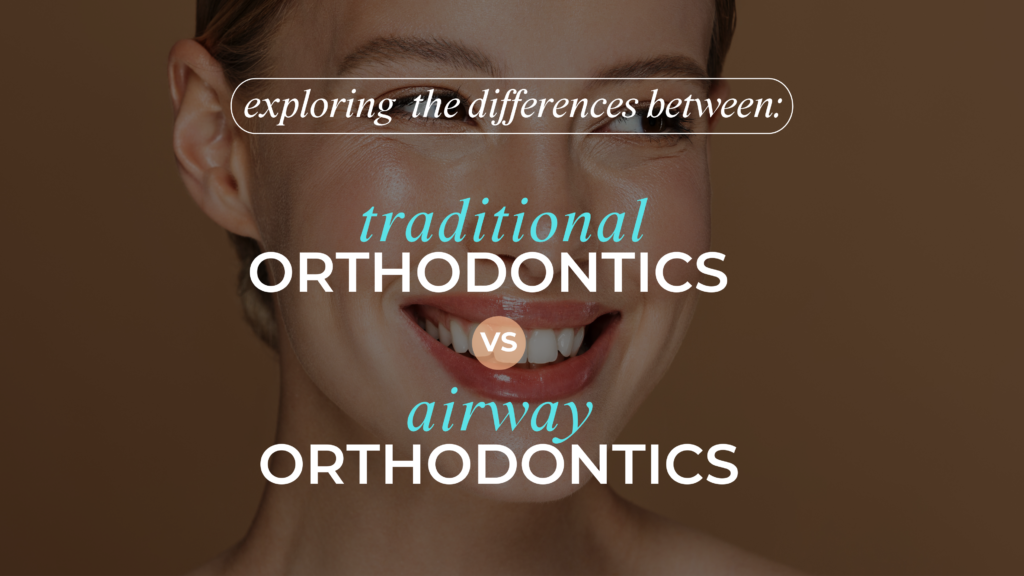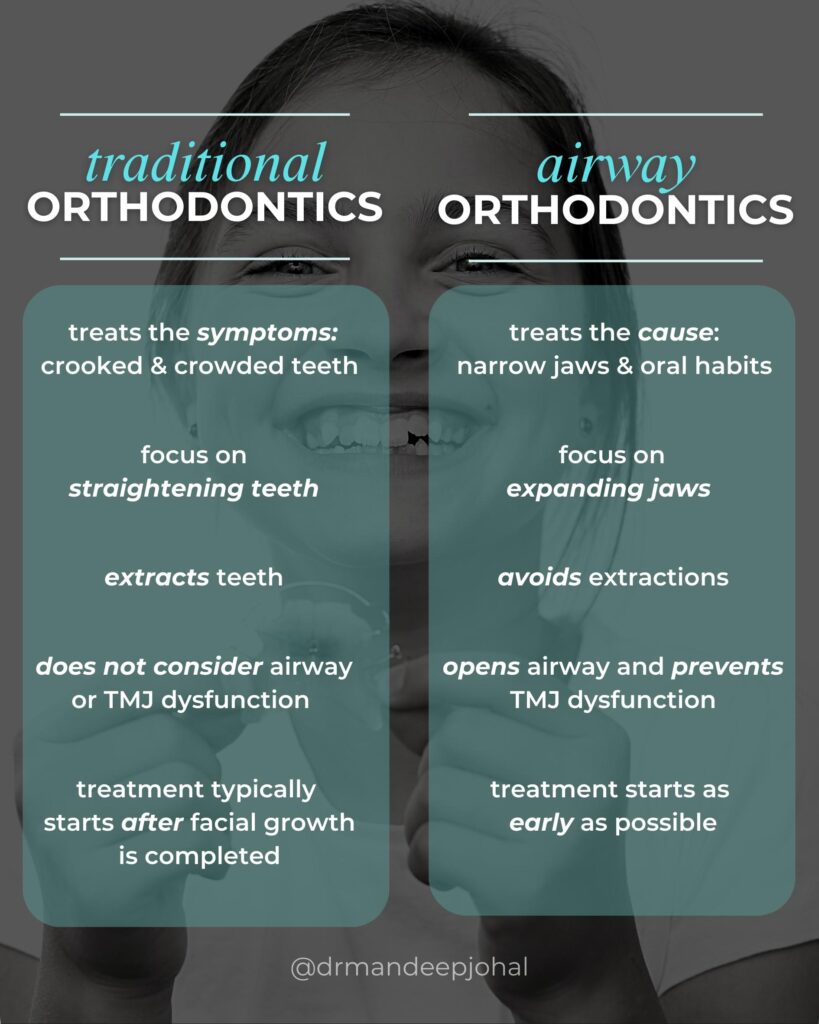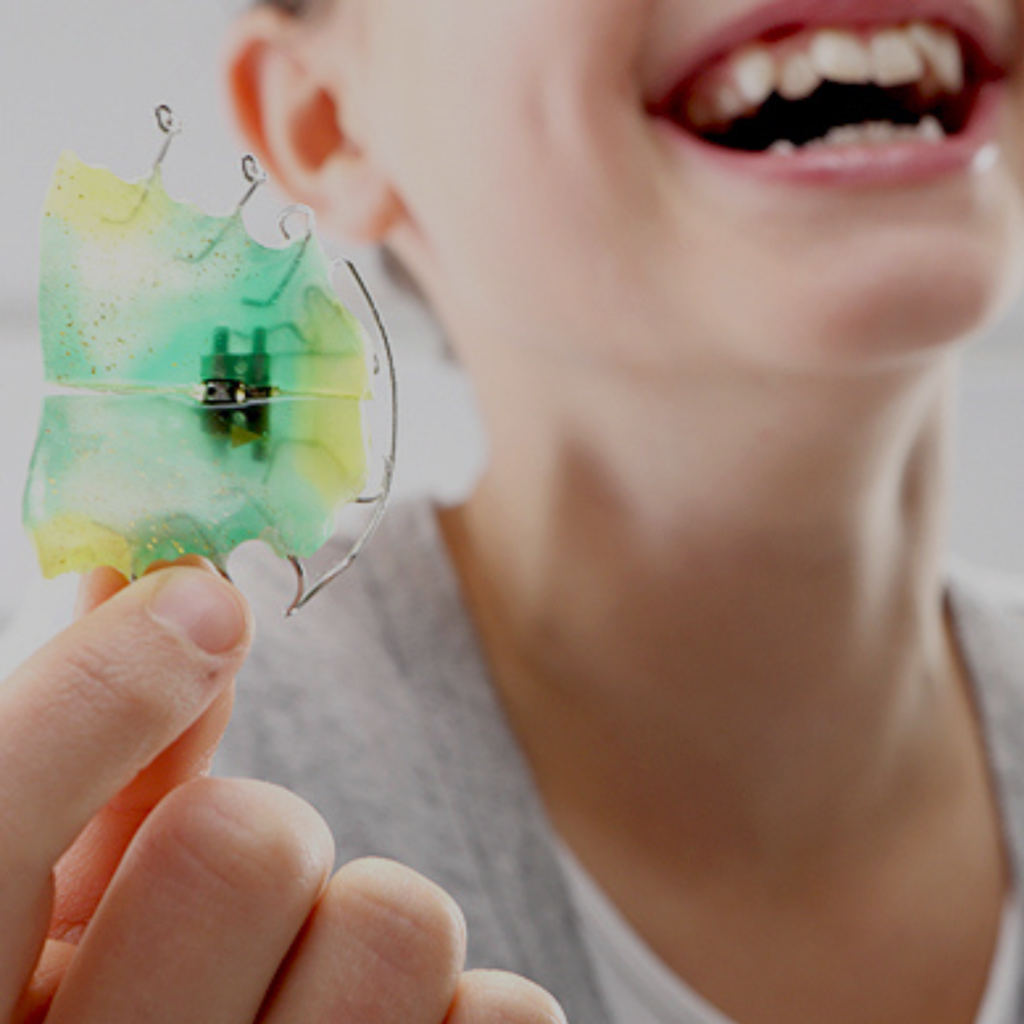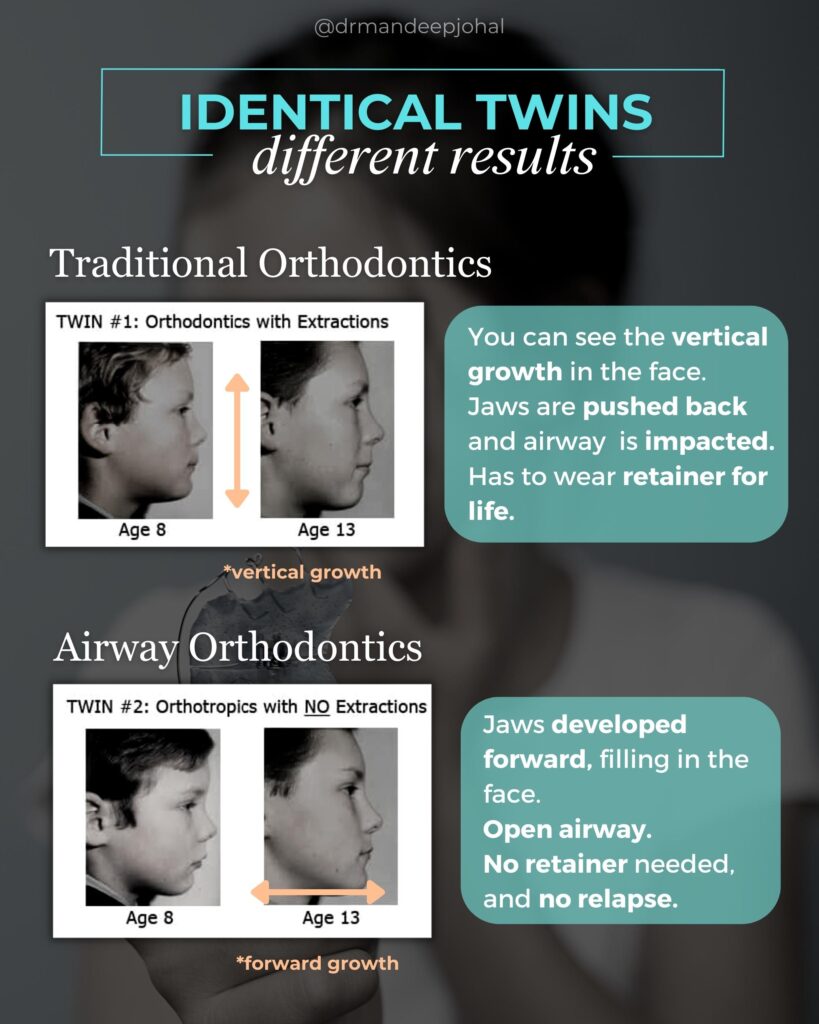Which is better: traditional orthodontics or airway orthodontics?
In the realm of orthodontics, there’s a captivating evolution taking place—one that transcends mere alignment and aesthetic enhancements. While traditional orthodontics has been the approach for decades, a revolutionary paradigm known as airway orthodontics is getting attention for its holistic perspective and transformative outcomes. In this article, we embark on a journey to unravel the disparities between these two approaches, shedding light on the benefits of airway orthodontics.

Beyond the Surface: A Deeper Dive into Orthodontics
Orthodontics has long been synonymous with achieving straight, beautiful smiles. Traditional orthodontics primarily focuses on repositioning teeth to enhance their alignment and overall appearance. But is there more to orthodontics than just straight teeth? Yes!
Airway orthodontics, on the other hand, ventures beyond the confinements of cosmetic alterations. It adopts a holistic, whole-body approach that considers the intricate interplay between oral health, systemic wellness, sleep, and proper breathing. It’s not just about teeth; it’s about addressing the root causes that manifest as orthodontic issues.
The Heart of the Matter: Correcting the Cause
One of the fundamental distinctions between the two approaches of orthodontics is the focal point of treatment. While traditional orthodontics works to treat the symptoms, crooked and crowded teeth, airway orthodontics works to treat the cause of crooked and crowded teeth.
Traditional orthodontics, in pursuit of cosmetic alignment, can often resort to more invasive methods, including the extraction of perfectly healthy teeth to create space in the jaw. However, this approach can have long term consequences, potentially leading to jaw misalignment and airway issues down the road. In contrast, airway orthodontics takes a less invasive route but utilizing expanders to create space within the jaw, thus facilitating better teeth alignment. Airway orthodontics acknowledges that narrow jaws don’t just manifest arbitrarily; they are a result of a complex interplay of factors, including oral habits, tongue posture, tongue ties, breathing patterns, and dietary choices. Airway orthodontics goes beyond just treating the symptom of crooked teeth, and rather investigates why the teeth and jaw developed that particular way. By delving into the underlying cause of poor jaw and teeth structure, airway orthodontics not only seeks to enhance the alignment of the teeth but also aims to improve the patients overall health and quality of life, all while achieving lasting and sustainable results.

The Traditional “Wait and See” Approach is Outdated
Did you know that 60% of a child’s face development is completed by age 6? And that 90% of their facial development is completed by age 12?!
Traditional orthodontists typically begin treatment when children are age 13 or older. At this age, the jaws, teeth, and face are fully developed, making treatment more invasive and often takes longer to achieve results.Airway orthodontics’ functional approach recognizes that there are many ways to encourage proper jaw and dental development as soon as it is recognized that the jaw and teeth are not developing properly. Because of this, the approach encourages beginning treatment as early as possible. Airway orthodontics aims to guide proper growth and development of the face, jaws, and teeth through various approaches, at all ages, to avoid invasive procedures in the future.

Exploring the Dichotomy: How Differences in Approach Lead to Varied Outcomes
What does all this matter if the outcome is the same? Well, its not!
Traditional orthodontics, while effective in straightening teeth, overlooks the underlying root cause of poor facial growth. Consequently, this approach has a higher risk of relapse and regression, with a common relapse of developing an open bite.
Let’s explore the differences in outcomes in this case of twins using both approaches:

In contrast, airway orthodontics takes a functional approach by addressing the core factors responsible for narrow jaws and malocclusion. By focusing on proper tongue posture, optimizing oral habits, and promoting airway health, airway orthodontics can offer long-lasting, sustainable results, including the prevention and correction of open bites. The divergence in approaches highlights the importance of considering not only the cosmetic aspects of orthodontic treatment, but also the long term health and functionality of the oral-facial complex.
Compliance, Commitment and Collaboration: The Pillars of Airway Orthodontics
Collaboration is key when it comes to achieving results. Working alongside other practitioners, including chiropractors, osteopaths, naturopaths, and myofunctional therapists is often a part of a patient’s treatment plan as well. Airway orthodontics treats the whole body and sees the connections between seemingly separate systems, which requires a collaborative approach with other practitioners and dedication and commitment from the patient.

Conclusion
As we conclude our exploration, the gap between traditional orthodontics and airway orthodontics is characterized by a shift in perspective—a transformation from isolated alignment to comprehensive well-being. Traditional orthodontics offers impressive aesthetics and alignment, while airway orthodontics presents a transformative journey that encompasses the entire body. Airway orthodontics serves as a reminder that our bodies are intricate systems where even the subtlest adjustments can ripple through multiple facets of our lives. As this paradigm continues to gain momentum, patients stand to benefit not only from radiant smiles but also from improved breathing, enhanced sleep, and a renewed vitality that springs from within. The choice between the two is a matter of personal priorities and goals, but the emergence of airway orthodontics undeniably ushers in a new horizon of dental wellness—one that embraces function, form, and the interconnections between oral and overall health.
Contact Information
If you have any questions or would like to schedule an in-person or virtual appointment with Dr. Johal, please contact us here.
If you would like to refer us to someone you know that this information is relevant to, please complete our referral form here.
Home: www.familydentalguelph.com
Stay in Touch with Dr. Johal: www.drmandeepjohal.com
Visit our Tongue Tie Centre: Tongue Tie Centre Guelph and Ontario
Family Dental Centre
1482 Gordon Street, Guelph
519-767-2729
www.familydentalguelph.com









